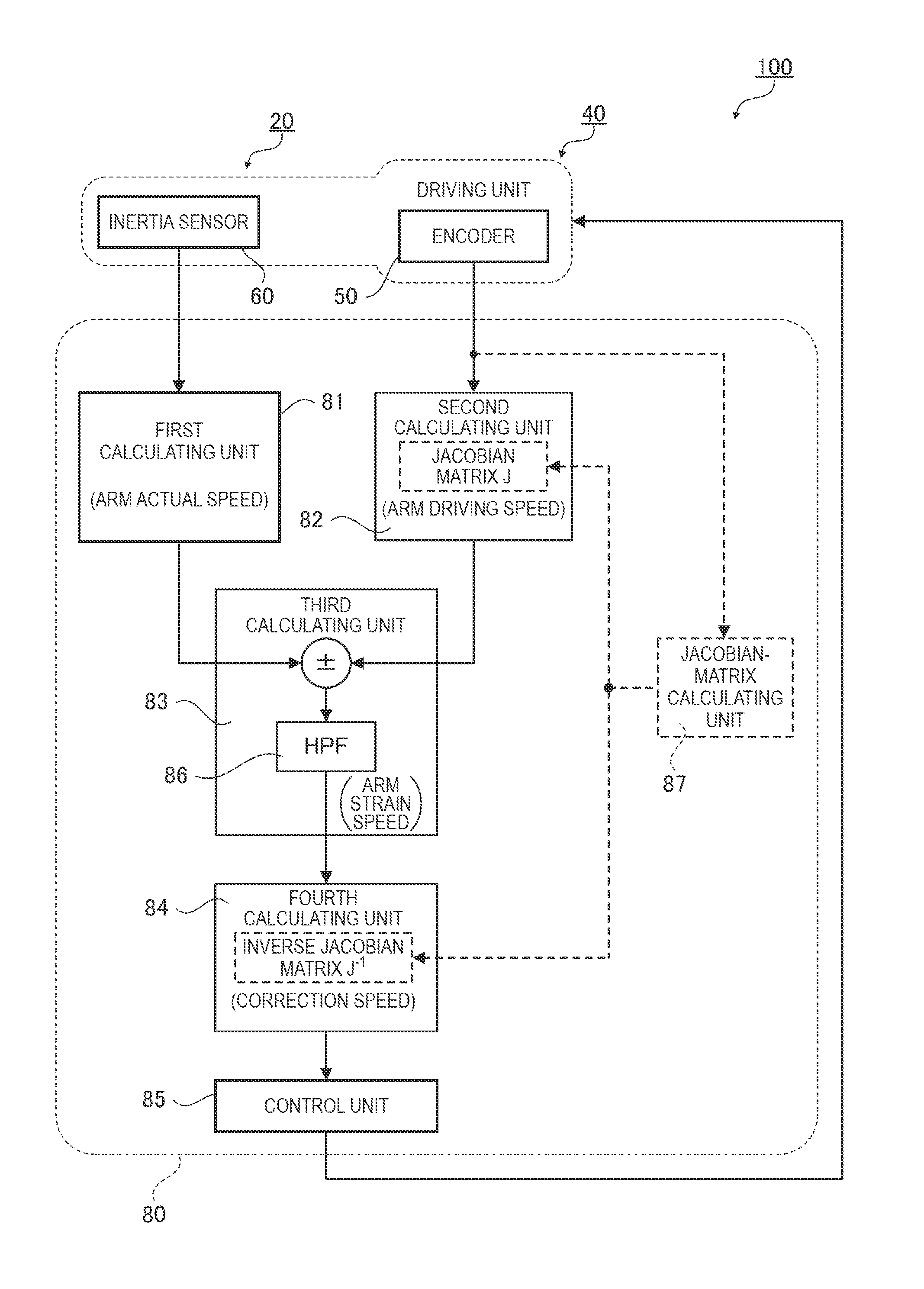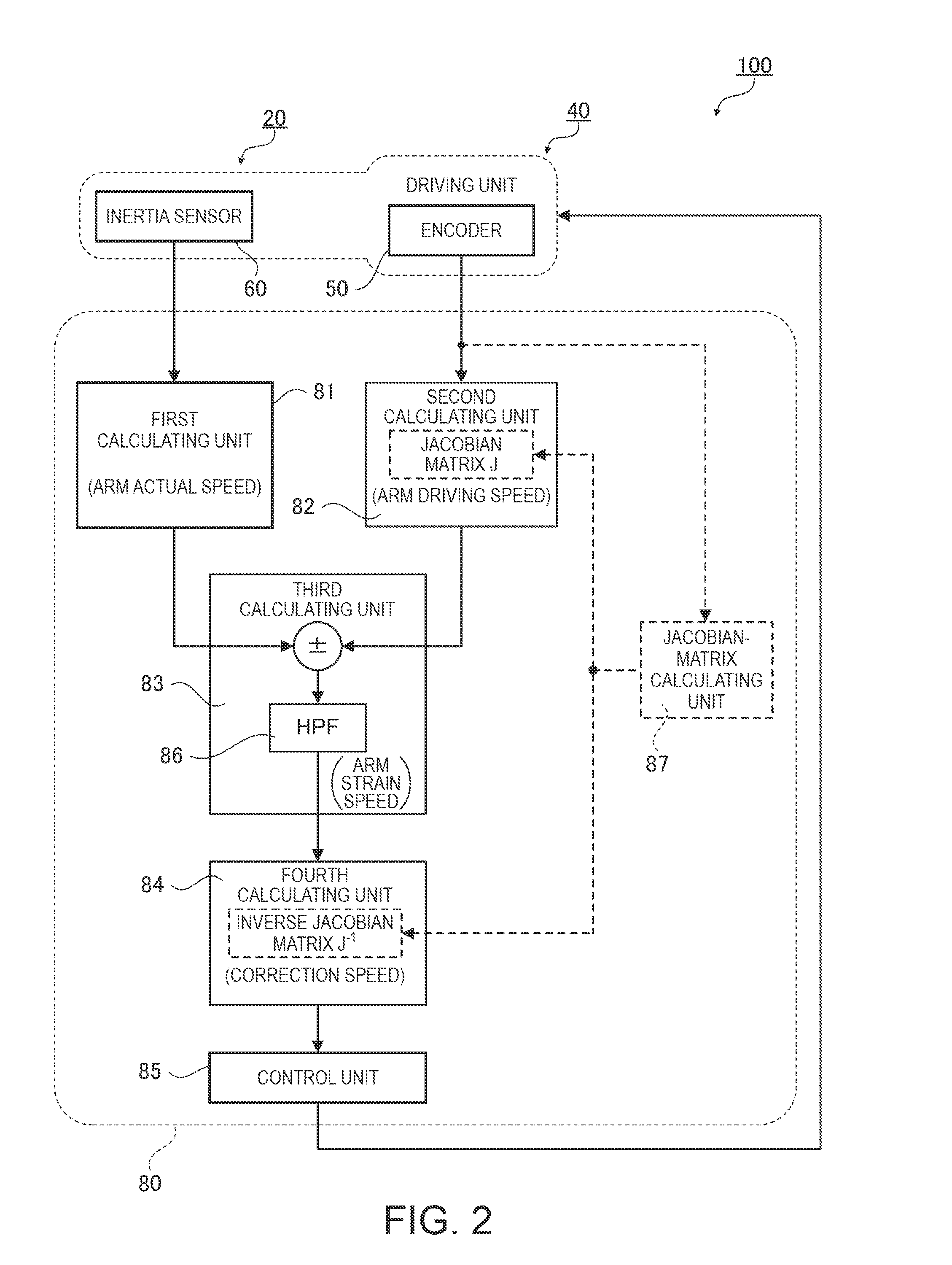Control device and control method for robot and the robot
a control device and robot technology, applied in the direction of programmed control, manipulators, instruments, etc., can solve the problems of deterioration of the accuracy of vibration caused by vibration, the inability to suppress vibration and motion strain, and the inability to move the robot arm
- Summary
- Abstract
- Description
- Claims
- Application Information
AI Technical Summary
Benefits of technology
Problems solved by technology
Method used
Image
Examples
first embodiment
[0039]First, a control device and a control method for a robot according to a first embodiment are explained.
[0040]FIG. 1 is a schematic diagram showing a link model of a robot 200 mounted with the control device for the robot according to the first embodiment. In FIG. 1, the control device for the robot is not shown.
[0041]The robot 200 is a six-axis multi-joint robot. The robot 200 includes an arm 20 including six coupled links 10 (10a to 10f), a robot main body 30 including the arm 20, and six driving units 40 (40a to 40f) configured to respectively drive the links 10.
[0042]In the following explanation, an “arm” includes a “structure in which a plurality of links are coupled”. Coupling sections functioning as joints for coupling the respective links include the driving units having a function of driving the respective links.
[0043]In the arm 20, the six links 10a to 10f are coupled in order via the driving units 40a to 40f. At a distal end portion of the link 10f forming one end of...
second embodiment
[0080]A control device and a control method for a robot according to a second embodiment are explained. In the explanation, components that are the same as the components in the first embodiment are denoted by the same reference numerals and signs and a redundant explanation of the components is omitted.
[0081]FIG. 4 is a schematic diagram showing a link model of a robot 201 mounted with the control device for the robot according to the second embodiment.
[0082]The robot 201 is a six-axis multi-joint robot same as the robot 200 mounted with a damping device 101 (not shown in the figure).
[0083]The damping device 101 is the same as the damping device 100 except that a gyro sensor (hereinafter, inertia sensor 61) that detects angular velocities (Rx′, Ry′, Rz′) of three axes is used as the inertia sensor. In this embodiment, the inertia sensor 61 is attached to the link 10d. That is, whereas the inertia sensor 60 is attached to the link 10f to suppress vibration in the distal end portion ...
third embodiment
[0092]A control device and a control method for a robot according to a third embodiment are explained. In the explanation, components that are the same as the components in the embodiments explained above are denoted by the same reference numerals and signs and a redundant explanation of the components is omitted.
[0093]FIG. 5 is a schematic diagram showing a link model of a robot 202 mounted with the control device of the robot according to the third embodiment.
[0094]The robot 202 is a double-arm multi-joint robot mounted with a damping device 102 (not shown in the figure). The robot 202 includes two arms 21 forming seven-axis double arms, a revolving arm 22, the robot main body 30, and the damping device 102.
[0095]In the arm 21, the seven links 11b to 11h are coupled in order via driving units 41b to 41h. At a distal end portion of the link 11h forming one end of the arm 21, a hand tool, a welding gun, a spray gun, or the like (not shown in the figure) is attached as a hand unit.
[0...
PUM
 Login to View More
Login to View More Abstract
Description
Claims
Application Information
 Login to View More
Login to View More - R&D
- Intellectual Property
- Life Sciences
- Materials
- Tech Scout
- Unparalleled Data Quality
- Higher Quality Content
- 60% Fewer Hallucinations
Browse by: Latest US Patents, China's latest patents, Technical Efficacy Thesaurus, Application Domain, Technology Topic, Popular Technical Reports.
© 2025 PatSnap. All rights reserved.Legal|Privacy policy|Modern Slavery Act Transparency Statement|Sitemap|About US| Contact US: help@patsnap.com



